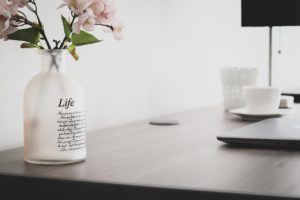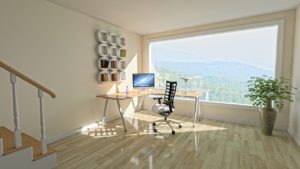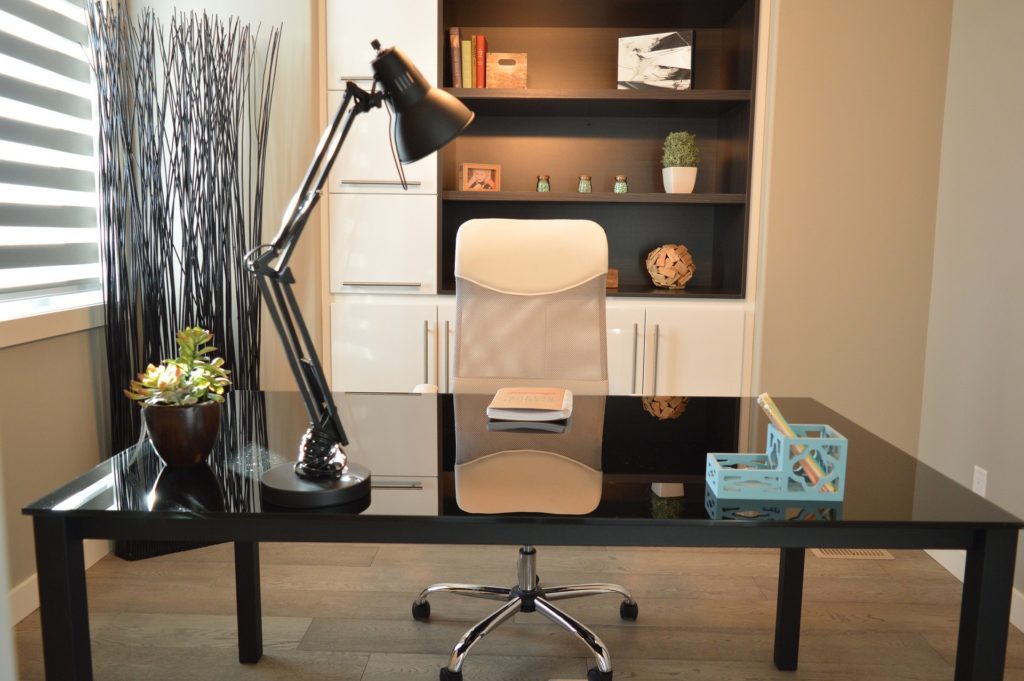A great home office balances the rigors of work and the relaxation of life in your most familiar and comfortable surroundings. But so often these spaces can end up feeling a little too “office” and not enough “home,” or vice versa. And that’s not good for business or pleasure.
To strike the right balance, consider these 13 decorating tips for perfecting your home office design.
1. Consider all angles. When working in a formal office scenario, the desk often gets crammed up against a cubicle wall. But one of the freedoms of working from home is often being able to sit at an angle with no cubicle to confine you. Angling your desk into the room diagonally can make even a tight office space (such as a small den with few windows) feel larger, giving the maximum amount of space between you and the opposite walls. Try moving your desk around until you feel the most comfortable — sometimes the right angle isn’t a “right” angle.
2. Float the shelves. When your “office” is really a small nook in the home, rather than a full room, adding floating shelves provides accessible storage that keeps clutter off your work surface. Make sure to include decorative elements on these shelves, like some inspiring books or art, so the overall look is still welcoming. Also, stick to light colors (such as white or pale wood) for the shelves. This keeps them from feeling too in-your-face.
3. Get a desk pad. Besides being an attractive and comfortable place to set your computer and rest your arms while typing, a desk pad can also help to define a space that is forbidden from collecting clutter. A large pad will set aside enough room to move your arms and accomplish tasks without knocking over objects or beverages.
4. Use a laptop. Some professions need a large desktop — or more — to work efficiently. If you don’t, consider skipping the massive monitor and work on just a laptop or tablet. This allows you to free up visual space and symbolically close the book on each workday, so you’re not always staring at a large black rectangle that’s reminding you of the work you still need to complete.

5. Dress up your desk with decor. One of the best parts about working from home is not being in a stuffy office. So why re-create a stuffy office at home? Include decorative elements in your office space, such as a chunky vase full of flowers, so you can enjoy the comforts of home all through the working hours.
6. Provide refreshments. Speaking of the comforts of home, the more everyday essentials you keep on hand, the less temptation there will be to wander away from your desk. If you know you’ll need frequent top-ups on your caffeine, try keeping a coffeemaker on or next to the desk. Or consider adding a beverage cart or a mini fridge, so sparkling water or sodas are always handy.
7. Stock office supplies nearby. For basic supplies like pens and pencils, think like an artist and use glass jars to keep everything in reach. The look is laid-back and stylish, and the fewer times you have to get up and search for supplies, the more productive you’ll be.
8. Incorporate pattern and color. It’s been shown that color and pattern help keep you creative and stimulated at work, so don’t be afraid that some lively hues will distract you. For a perfect balance, keep energetic colors in your periphery while sticking to a more subdued look for the desk. That way, you can concentrate while on a roll, and let your mind wander when you need to lean back for a minute.

10. Pin it. If you use a bulletin board for sticking up reminders, samples and the like, go for a larger size than necessary and include a few positive photos or inspiration images. Don’t let the board be all to-do lists and bills, or you won’t ever want to look at it.
11. Organize that paper. If you aren’t perfect at keeping your papers 100 percent organized on a daily basis, it’s wise to plan ahead and give yourself a temporary place to stash documents until they can be properly addressed. Otherwise they can easily pile up on the desk itself and become permanent clutter. Set aside a specific drawer or desktop organizer for loose papers, and make sure you sort them properly every Friday before you finish the workweek (or on Monday as a reset).
12. Invest in practical lamps. A properly lit space is crucial to maintaining your mood, productivity and health. Bad lighting can strain your eyes, especially if you’re staring at a bright screen in the dark. General background illumination can help. But instead of a harsh spotlight, go for a decorative table lamp with a warm glow. To save space, you can also replace the desk lamp with a floor lamp or even a wall-mounted light like a swing-arm plug-in sconce. This frees up 10 to 16 inches of space and lets the light diffuse a little before reaching the desk, to light a wider area more evenly.
13. Corral clutter with serving trays. If your desk is multifunctional or in a room (such as a guest room or den) that serves other purposes besides work, a serving tray gives you a place to stash items and easily move them out of the way. For example, keep your office supplies in jars on a tray, and you can move them over to a nearby shelf on the weekend. Or keep a beverage carafe and glasses on a tray and bring them in to fill the desk when it’s time to declare the workweek over.
